Written by SmartSense | Food Safety, Supply Chain
Explore solutions built for your industry
Our customer-proven solutions monitor medications and food inventories for some of the most recognizable names in the industries of healthcare, food service, and transportation, and logistics. See how our solutions adapt to your industry needs.
SEE SOLUTIONSKroger Health Strengthens Compliance Visibility with SmartSense
Watch The VideoLEARN
Questions? Call +1 (866) 806-2653 to speak to our experts.
Schedule demoQuestions? Contact us.
Call +1 (866) 806-2653 to speak with our experts or get started with a demo.
CONTACT USAbout Us
SmartSense was created to use the power of the Internet of Things (IoT) to help our customers protect the assets most critical to the success of their business.
See our storyCONNECT. PROTECT. RESULTS.
Questions? Call +1 (866) 806-2653 to speak to our experts.
Schedule demoPlease select your login
June 13, 2019
The 2019 Digi Global IoT Conference
Last week we held our exclusive 2019 Digi Global IoT Conference to bring together a select group of executives and industry leaders.
We immersed our customers in the latest IoT technology and networking trends, connected them with the most progressive minds in IoT, and shared product updates and new developments.
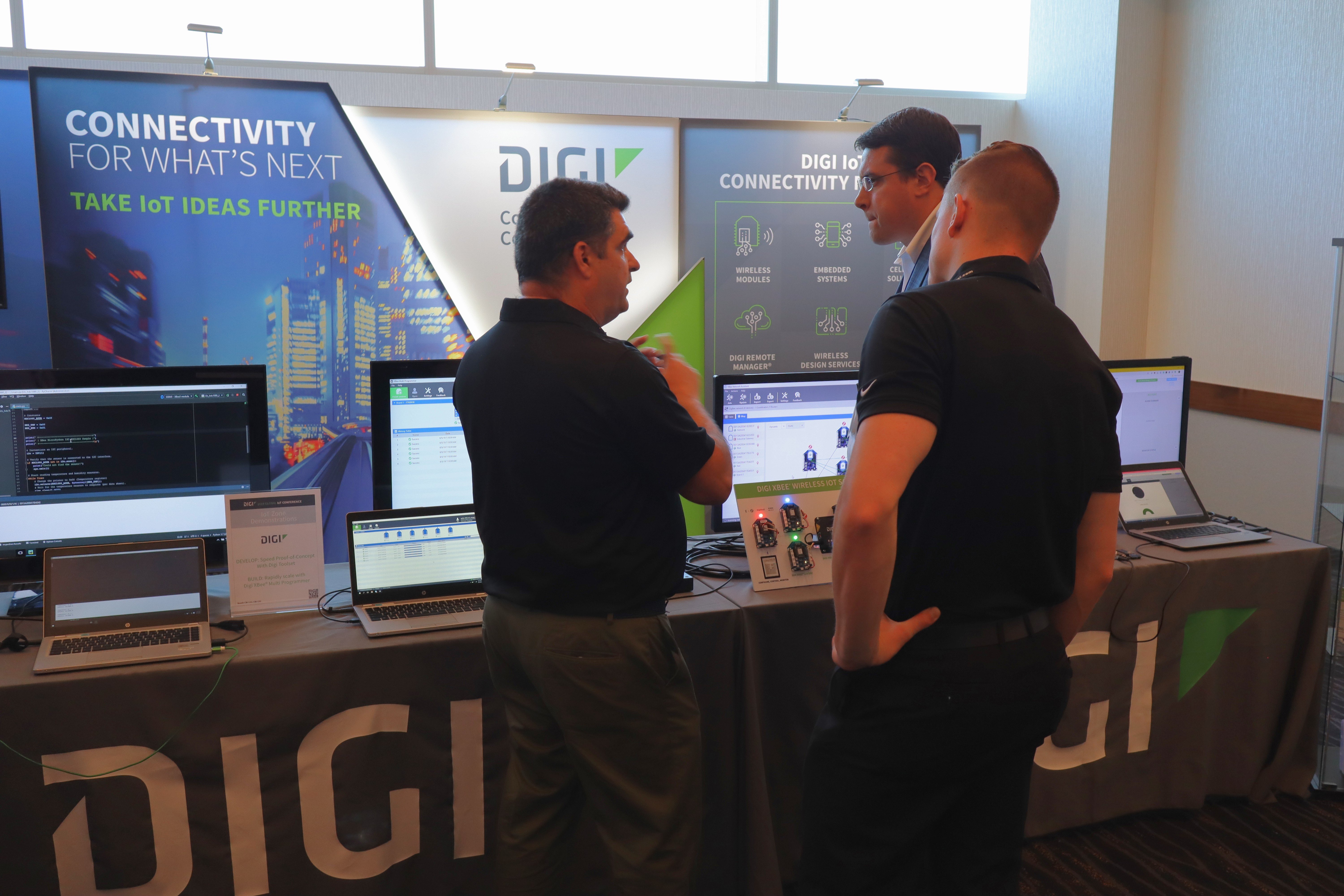
The Digi booth, one of the many tables setup for our guests to explore the future of IoT.
With 3 tracks, 20 sessions, and 25 speakers, our conference attendees had no shortage of topics to explore. We’ve compiled a select list here to share some of the incredible insights the SmartSense team and our customers have shared.
From Paper to the Cloud
Josh Tate, Senior Manager of Store Support and Operations at RaceTrac gas stations, started off our sessions outlining his journey of adopting IoT into his business. Founded in 1934, RaceTrac has become one of the top 100 privately held companies by Forbes, and recently became the 2nd largest privately-held company in Georgia.
Throughout its 85 years of existence, RaceTrac has evolved its food strategy to incorporate freshly prepared and made-to-order food offerings. Naturally, this led to more discipline around food safety. To combat the increased risk in foodborne illness and reduce the time spent on manual processes, RaceTrac had 7 key considerations for determining the best IoT vendor.
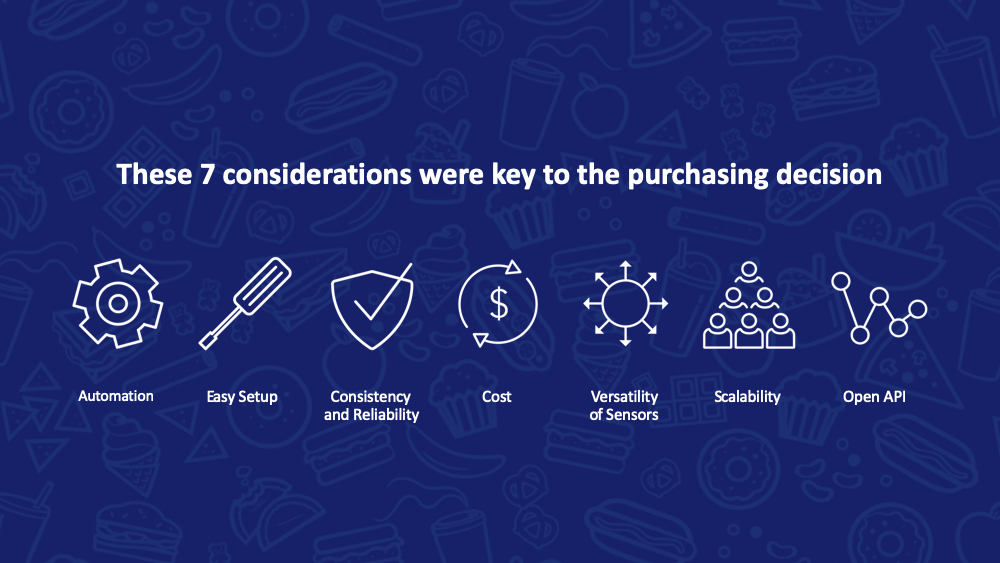
The 7 consideration RaceTrac had when evaluating an IoT solution.
As a result, RaceTrac has saved labor hours, gained access to 24/7 monitoring capabilities, and now has 100% visibility and accountability into their food safety tasks. These capabilities were not possible with their manual food safety efforts, and has provided peace of mind that their food is safe for their customers.
Deploying 10,000 IoT Environments
Greg Carter, Chief Customer Officer here at SmartSense, gave a presentation on the challenges of deploying IoT environments at scale. Unfortunately, many of these projects fail for a number of reasons, including:
- Lack of experience by the project manager
- Using the wrong methodology
- Lack of customer engagement
- Inexperienced development team
- Lack of leadership
- Lack of ownership
- Failure to separate research from development
- Lack of accountability
- Lack of proper training
- Improper scope definition
- Team’s overconfidence
Despite the seemingly endless problems that can arise from IoT networks, Greg and his team have mastered the deployment process and identified the pros and cons of the 2 methods of installation: managed through a third-party vendor or completed in-house.
Managed vs Self Installations
Managed installations are coordinated and completed by an external vendor, primarily done by the organization that is providing the hardware. This brings the advantage of placing responsibility of the installation process on the external vendor, allowing for a more seamless transition to the new solution. This, however, increases costs and can be subject to schedule changes as more people are involved than through a self installation.
Self installations occur when the customer manages the deployment process. This can be challenging for anyone unfamiliar with the complexity of an IoT network, but provides a DIY approach for companies willing to take on this burden. Additionally, timelines are easier to maintain and costs are reduced, as fewer people are involved.
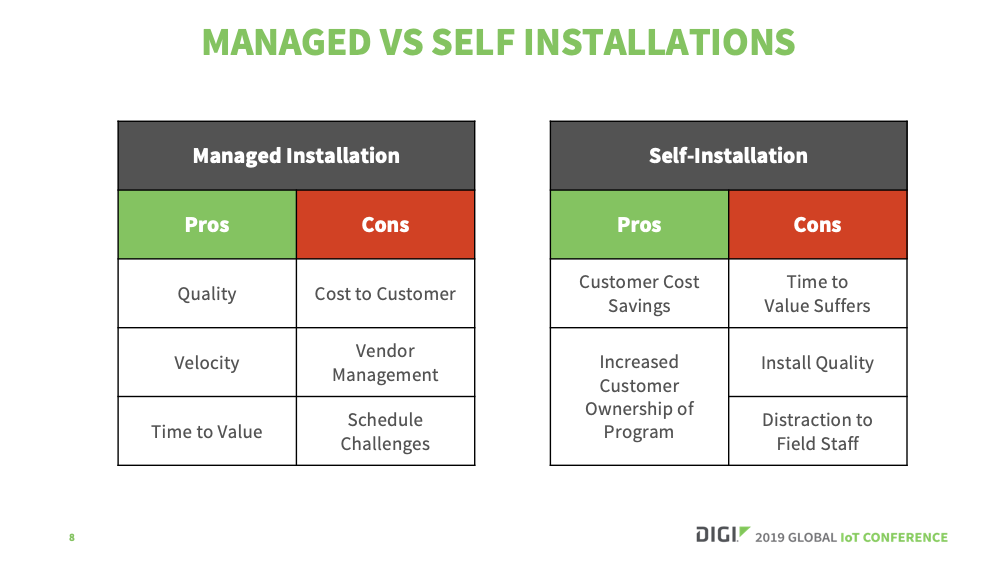
The pros and cons of a managed vs self installation.
Greg concludes his talk with a simple idea: plan carefully, and start slow. So long as the process is well managed and understood, IoT deployments can be completed in weeks, not months. Above all else, learn your lessons learned. Growth comes from within, and requires careful consideration of what went wrong and what went right.
How Real-Time Data Drives an Ultra-Responsive Supply Chain
Colin Warkentin, CTO of Transportation and Logistics at SmartSense, brought us through the evolution of business transformation in the supply chain industry by means of more robust data collection. Previously, IoT was inaccessible to most businesses. A combination of advances in technology and a reduction of networking costs has made this widely available.
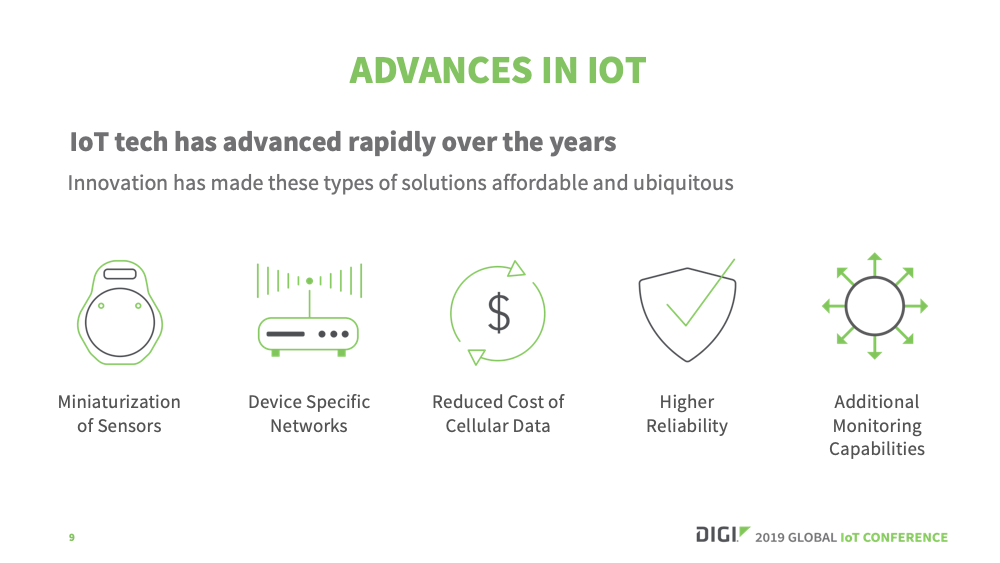
Innovation has made IoT more affordable and ubiquitous.
Before IoT technology matured, the cold chain relied on single point temperature monitoring. This meant that temperatures were recorded at shipment and at delivery, but lacked visibility between these two end points. As technology advanced, continuous temperature monitoring became a reality, which enabled confirmation of temperatures during shipment, as opposed to being confined to the start and end of a shipment. Once IoT became prevalent, real-time temperature and location data became available. This allowed for proactive management of the supply chain and enabled ultra-responsive decision making in response to this new-found visibility.
Transforming Data into Future Insights
Jason Sroka, VP of Analytics at SmartSense, gave an in-depth overview of effective frameworks for leveraging data to drive accurate predictions. These 3 frameworks enable organizations to go from manual to automated data collection, and ensure that the data that is collected is being analyzed successfully.

Frameworks for successful analytics efforts.
Successful Analytics Efforts
In order to drive successful analytics efforts, businesses must meet 3 basic criteria: technical skills, data science, and domain knowledge. Technical skills include the means of capturing and storing data for analysis, such as implementing automated temperature monitoring in lieu of manual data collection. Data science is simply the ability to analyze and make sense of the data that has been collected. Lastly, domain knowledge is understanding context to the data. What it is, why it matters, and how to use it.
Maturity Model
The Maturity Model encompasses four stages of capabilities that help businesses transition from manual data collection to intelligent business processes that prevent problems before they occur. The first stage, Collection Automation, is the idea of automating manual processes. Next, Descriptive Analytics automates the interpretation of the newly collected data. Predictive Analytics then takes the automated interpretations and predicts future events. Finally, Prescriptive Analytics improves responses to these predictions by analyzing their outcomes.
Prediction Machines
The final framework is outlined by Dr. Ajay Agrawal in his book, Prediction Machines. In it, he describes how the cost of prediction (any interpretation of data) is dropping fast due to techniques and tools driving accessible computational models. This drop in cost increases the value of judgement, which requires domain knowledge and expertise as outlined above. Despite the rising prevalence of technology, the value of human judgement will continue to increase.
The True Costs of Paper-Based Workflows
Jeff Reiger, Senior Product Director at SmartSense, walked us through the costs of paper-processes, and the advantages of going digital. Many organizations run their day-to-day operations via paper checklists, including compliance management, food safety tasks, and maintaining standard operating procedures (SOPs). This leads to unnecessary burden and hidden costs as a result of these manual workflows.
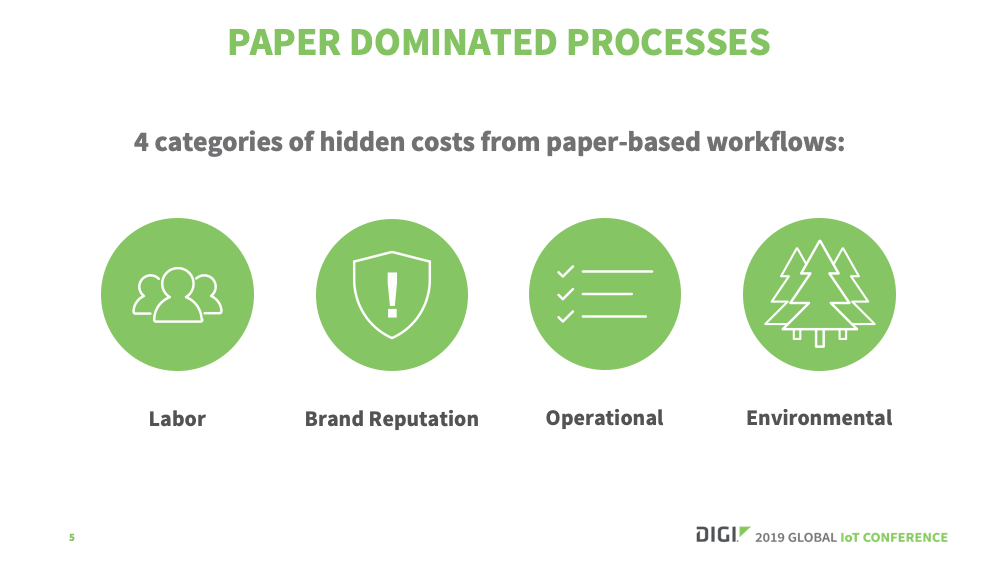
The 4 costs of paper dominated processes: labor, brand reputation, operational, and environmental.
Labor-intensive operational checklists and food safety tasks add unnecessary costs to businesses. These include tasks that can be automated by means of a digital solution. Manual logging is error-prone and does not catch problems before they occur, leading to Jeff’s next hidden cost: brand reputation. It takes just one negative incident for a company’s brand to be forever tarnished. Without a digital solution, manual processes will leave organizations in the dark and unable to stop problems before they occur. In addition to labor costs, operational costs are significant for businesses who need to prioritize resources in response to a lack of automated data collection. Finally, paper-processes use, you guessed it, paper. This creates an undue burden on our environment, both in terms of the trees necessary to supply the paper, and the need to drive to individual store locations to analyze logs.
The 2019 Digi Global IoT Conference supplied industry leaders with a glimpse into the future of SmartSense, and more broadly, the future of IoT. We had a blast and hope to see you next year!
Subscribe to Connected Insights!
Subscribe to our blog to get regular email updates on food safety, pharmacy safety, and supply chain insights.
Topics:
Food Safety
Supply Chain
Other Suggested Posts
Why Customer Success Makes the Difference in Your Condition Monitoring Program
If your business objective is to implement an efficient and successful condition monitoring program, gone are the days of “set it and forget it.” Today’s savvy ...
Why K-12 School Cafeterias Are Automating Food Safety
During the COVID-19 pandemic, there were significant disruptions to K-12 school food services nationwide. School nutrition directors were forced to rapidly ...
Frozenomics: Why Freezers Are Becoming America's Financial Lifeline
When times get tough, Americans get creative with how they stretch budgets. That's why today's shoppers are fighting inflation and financial strain with an ...
How Machine Learning Elevates Traditional Temperature Monitoring
While a minority of food companies and healthcare organizations continue to manually collect temperature logs to meet compliance regulations, most enterprises ...
Creating a Customer-Centric Food Chain with Sensing-as-a-Service
The food service industry is undergoing an era of labor uncertainty and demand volatility. The reasons are many and complex: the rise of e-commerce, supply ...
Subscribe to the SmartSense Blog
Stay up-to-date on the evolution of IoT connectivity.
CONNECT. PROTECT. RESULTS.
Learn how our complete critical
environment monitoring solution will help you
connect and transform your business.
Call +1 (866) 806-2653 to speak with our industry
experts or get started by
requesting a demo.
